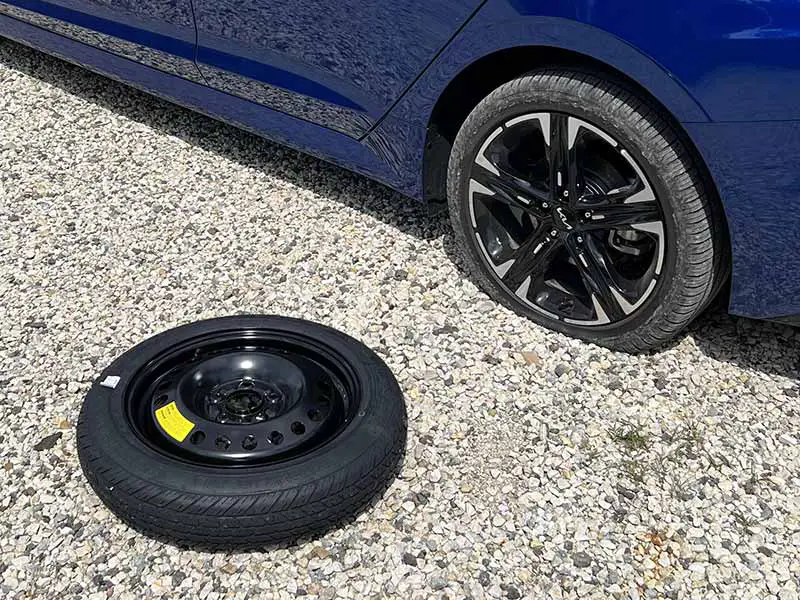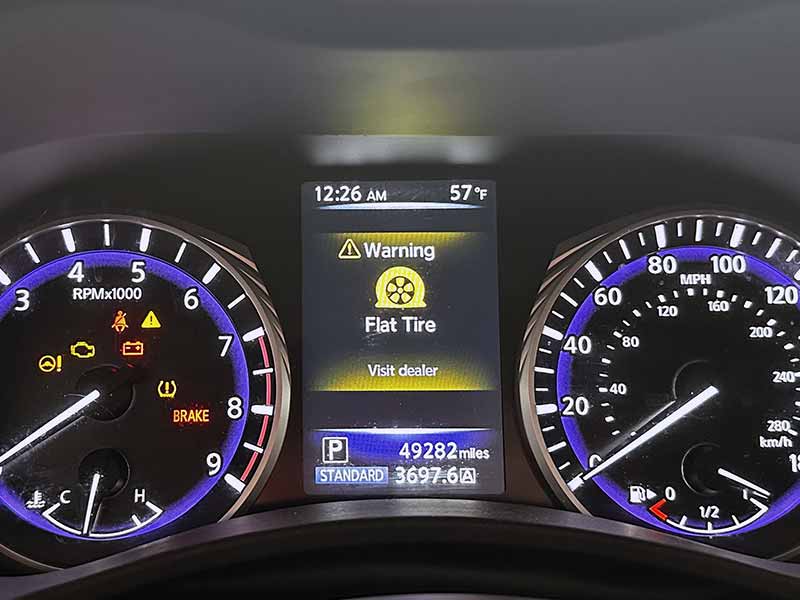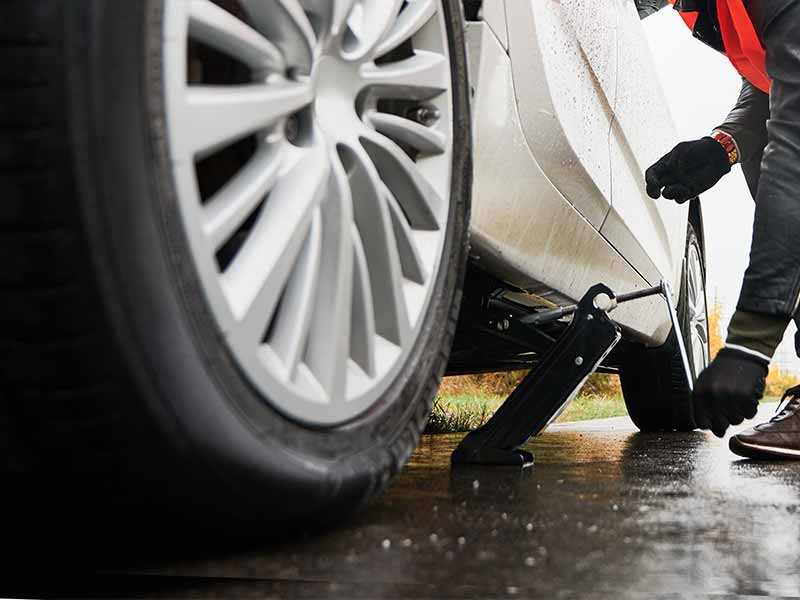Ever parked your car in the evening only to find a flat tire waiting for you the next morning? It’s not just bad luck; there’s science and mechanics behind it. Understanding why this happens could save you time, money, and a whole lot of stress.
Tire Went Flat While Parked!
Tires can go flat while parked due to various reasons such as temperature changes, valve stem issues, or slow leaks. Addressing these factors promptly can prevent further damage to your tire and wheel assembly.
In this article, we’ll unravel the mysteries behind overnight flat tires, explore the risks of leaving your car parked on a flat, and explain what to do. This comprehensive guide has got you covered.
Let’s take a closer look.

The Mystery of the Overnight Flat
You park your car in the evening, and everything seems fine. But the next morning, you find one of your tires is flat. Oddly enough, when you inflate it, the tire seems to hold air just fine. What’s going on? This phenomenon is not as uncommon as you might think, and there are several factors that could be at play.
Temperature Changes
- Air Contracts: One of the most common reasons for this overnight flat mystery is a significant drop in temperature. Air contracts when it gets colder, which can lead to a decrease in tire pressure.
- Low Starting Pressure: If your tire was already at the lower end of the acceptable pressure range, this contraction could push it into the “flat tire” territory.
Valve Stem Issues
The valve stem is the tiny protrusion from your tire that you unscrew when you need to inflate it. Sometimes, the valve stem can have minor issues that you might not notice.
- Slow Leak: A malfunctioning valve stem can cause a slow leak, which might not be noticeable during regular use but becomes apparent when the car is parked for an extended period.
- Temporary Seal: Sometimes, the valve stem can seal itself temporarily due to moisture or debris, making it seem like the tire is holding air again when you inflate it.
Internal Structure and Slow Leaks
Tires are more than just rubber; they have an internal structure made of various materials like steel and fabric. A slow leak might not be from the outer rubber layer but from the internal structure.
- Microscopic Damage: Sometimes, the internal structure can have microscopic damage that allows air to escape slowly.
- Sealing Itself: In some cases, the tire’s own weight and the air pressure inside can temporarily seal these minor leaks, making it seem like the tire is perfectly fine.
Quick Checks for Overnight Flats
If you experience an overnight flat, here are some quick checks you can do:
- Tire Pressure: Always check the tire pressure in all your tires, not just the flat one.
- Visual Inspection: Look for any obvious signs of damage or objects like nails or screws that might have punctured the tire.
- Valve Stem: Check the valve stem for any signs of damage or leaks.

Can a Tire Go Flat Without a Leak?
You might be scratching your head, wondering how a tire can go flat without an obvious leak. It sounds counterintuitive, but it’s entirely possible. Let’s delve into the mechanics and science behind this puzzling situation.
The Internal Structure of a Tire
Tires are not just simple rubber balloons filled with air. They are complex structures made from multiple layers of rubber, fabric, and steel wires.
- Inner Liner: This is the innermost layer of a tire, designed to keep air inside. However, it’s not always 100% impermeable.
- Carcass Ply: This layer provides the structural integrity of the tire. It’s usually made of fabric cords embedded in rubber.
- Steel Belts: These give the tire stability and make the tread pattern flat, which improves traction.
Air Molecules and Tire Permeability
- Natural Escape: Believe it or not, air molecules can escape through the rubber due to its natural permeability. This is a slow process but can lead to a flat tire over an extended period.
- Temperature Effects: Just like in the case of overnight flats, temperature changes can affect the air pressure inside the tire, even without a leak.
The Role of the Wheel Assembly
The wheel assembly includes not just the tire but also the rim, which holds the tire in place. Sometimes, the issue might not be with the tire itself but with the wheel assembly.
- Rim Damage: A damaged or corroded rim can cause a poor seal where the tire meets the rim, leading to a slow loss of air.
- Bead Leak: The bead is the edge of the tire that sits on the rim. If it’s damaged or not seated correctly, it can cause a slow leak without any puncture in the tire itself.
What to Do If Your Tire Goes Flat Without a Leak
- Check the Rim: Inspect the rim for any signs of damage or corrosion.
- Inspect the Bead: Make sure the bead is seated correctly on the rim.
- Tire Pressure: As always, check the tire pressure and inflate it to the manufacturer’s recommended level.
- Professional Help: If you can’t find the cause, it’s best to consult a repair shop for a thorough inspection.

How Long Before a Tire Goes Flat?
You might be wondering how long it takes for a tire to go flat, especially if you’ve noticed it losing air. The answer isn’t straightforward because several variables come into play. Let’s explore these factors in detail.
Slow Leaks: The Silent Culprit
- What is a Slow Leak?: A slow leak is a minor puncture or issue that causes the tire to lose air gradually, often going unnoticed until the tire is visibly flat.
- How to Detect: You might notice a slow leak if your tire pressure is consistently lower than it should be, even after you’ve inflated it to the recommended level.
Factors Affecting the Speed of a Flat
- Size of the Puncture: The larger the hole, the faster the tire will lose air. A small nail might cause a slow leak, while a large piece of debris can result in a rapid deflation.
- Tire Pressure: Lower initial tire pressure can accelerate the rate at which a tire goes flat.
- Driving Conditions: Rough roads can exacerbate a minor issue, causing the tire to go flat more quickly.
Low Tire Pressure: A Double-Edged Sword
- Fuel Efficiency: Driving with low tire pressure can reduce fuel efficiency.
- Tire Wear: Low tire pressure can also lead to uneven tire wear, which in turn can make the tire go flat more quickly.
Run Flat Tires: A Temporary Lifesaver
- What Are They?: Run flat tires are designed to be driven for a short distance even after they lose air.
- Limitations: However, they can only go so far and so fast before they too become damaged.
How to Monitor Your Tires
- Regular Checks: Make it a habit to check your tire pressure at least once a month.
- Use a Gauge: A tire pressure gauge is a simple tool that can give you an accurate reading.
- Visual Inspection: Look for signs of wear, damage, or embedded objects like nails or screws.

The Dangers of Leaving a Car Parked with a Flat Tire
You might think that leaving your car parked with a flat tire for a few hours or even days won’t do much harm. However, this seemingly harmless act can lead to a series of problems that could end up costing you more in the long run. Let’s delve into why it’s a bad idea.
Damage to the Wheel Assembly
- What is the Wheel Assembly?: The wheel assembly includes the tire, rim, and other components that allow your vehicle to move.
- How It Gets Damaged: When a tire is flat, the weight of the car can cause undue stress on the wheel assembly, leading to potential damage.
Internal Structure Complications
- Deformation: The internal structure of the tire can get deformed when it bears the weight of the car while flat.
- Long-Term Damage: This deformation can lead to long-term damage, making the tire unsafe for future use.
Flat Spots and Uneven Wear
- What Are Flat Spots?: When a tire remains flat for an extended period, the area in contact with the ground can develop a flat spot.
- Uneven Wear: Flat spots can lead to uneven wear when you finally do inflate the tire and drive, affecting the tire’s lifespan and performance.
Extended Period: The Longer, The Worse
- Immediate Effects: Even a few hours can start to cause damage, especially to the internal structure of the tire.
- Long-Term Effects: Leaving a car parked with a flat tire for days or weeks can result in irreversible damage, not just to the tire but also to the wheel assembly.
Financial Consequences
- Cost of New Tires: Damaged tires will need to be replaced, which can be costly.
- Additional Repairs: Damage to the wheel assembly can lead to other necessary repairs, adding to the financial burden.
What to Do If You Have a Flat
- Temporary Fix: If possible, use a tire inflator or sealant as a temporary fix until you can get to a repair shop.
- Spare Tire: Use your spare tire if you have one.
- Tow Service: In extreme cases, it might be best to tow your car to a repair shop rather than risk driving on a flat tire.
Resources
Below are some links you may find helpful when learning about tires
- What is temporary tire flat-spotting? – Tire Rack
- My tires have no holes-so why are they going flat? – Popular Mechanics
Final Thoughts
Understanding the intricacies of tire care can save you from the inconvenience and potential hazards of flat tires. Regular maintenance, prompt action when you notice issues, and a well-maintained spare tire are your best defenses against unexpected flats.
Whether you’re dealing with a puzzling overnight flat or wondering how long you can drive on a flat tire, being informed and prepared is key. So the next time you find yourself facing a flat tire, you’ll know exactly what to do.
Good luck and happy motoring.





